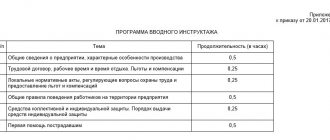Home › Training › Labor protection training for managers and specialists
The Training Center of the LABOR Institute offers training in the field of labor protection in various formats.
- In person;
- Remotely;
- In webinar format.
Training is conducted by professionals with a high level of competence:
- qualified teachers with practical experience in the field of labor protection and industrial safety;
- members of working groups involved in the development of bills and by-laws;
- experts with international experience.
Occupational safety training: what is it?
Current need
Labor activity, to one degree or another, has a negative impact on the health of workers. The high level of industrial injuries and occupational diseases indicates the need to find new methods and means of preventing them.
International experience convinces us of the effectiveness of an integrated approach to solving the problem. It is based on 2 directions:
- professional approach to occupational safety training;
- internal motivation of workers, consisting in strict compliance with all safety standards and regulations established in production.
Objectives of occupational safety training
The main purpose of training and knowledge testing:
- increasing the level of labor safety prevention;
- reduction of injuries at work;
- reduction in the level of occupational diseases.
Training objectives for managers of organizations and structural divisions:
- increasing the efficiency of the labor protection system at work;
- formation of competencies in the modern organization of management and management of the labor protection system;
- improving working conditions for workers;
- reducing the likelihood of accidents and injuries at work.
Goals of employee training:
- safe working conditions that allow you to preserve life and health.
The occupational safety training system includes 2 blocks:
- compulsory training - for all employees, managers, employers of enterprises and organizations.
- additional training - for employers with an increased level of responsibility, the desire to achieve an increased level of labor protection, the absence of injuries, and the formation of a business reputation. And also for workers seeking to acquire new competencies that are in demand due to changing characteristics of work activity.
Contents of compulsory training
1. Occupational safety training program (40 hours)
- Mandatory study for all employees and managers of the enterprise.
- Normative base:
- Resolution of the Ministry of Labor of the Russian Federation and the Ministry of Education of the Russian Federation dated January 13, 2003 No. 1/29 “On approval of the Procedure for training in labor protection and testing knowledge of labor protection requirements for employees of organizations” with amendments and additions dated November 30, 2021.
2. Professional retraining
- Mandatory for occupational safety specialists (current and future) who do not have relevant education.
- Normative base:
- Professional standard “Specialist in the field of labor protection”;
- Order of the Ministry of Health and Social Development of Russia dated May 17, 2012 N 559n “On approval of the Unified Qualification Directory of positions of managers, specialists and employees, section “Qualification characteristics of positions of managers and specialists carrying out work in the field of labor protection.”
Remember the main thing
- Occupational safety training includes instruction on labor protection and training in safe work methods for managers, specialists and employees.
- Occupational safety briefing has a number of distinctive features, including: its short duration, an oral form of questioning on acquired knowledge, and frequency.
- Without instructions on labor protection, an employee cannot be allowed to work, and without training he can begin to perform his duties.
- Employees entering work must undergo both labor safety instruction and training in safe work methods.
Source: Occupational safety: simple and clear
Contents of additional training
1. Advanced training program (72 hours) - in-depth compulsory training program (40 hours)
IMPORTANT! Training under advanced training programs (72 hours) can replace compulsory training (40 hours).
- Managers and specialists of labor protection services, members of commissions for testing knowledge of labor protection requirements.
- Regulatory base: GOST 12.0.004-2015. "Interstate standard. System of occupational safety standards. Organization of occupational safety training. General provisions."
2. Variable programs for advanced training and professional retraining
- They include practice-oriented forms and methods: seminars, corporate trainings, business games, quests.
- The direction of training is to improve competencies in the field of labor protection.
Labor protection training and testing of knowledge of labor protection requirements for employees of organizations
Occupational safety training is provided to:
- Employers, their deputies in charge of labor protection issues, deputy chief engineers for labor protection, employers - individuals, other persons engaged in business activities.
- Managers, specialists, engineering and technical workers who organize, manage and carry out work at workplaces and in production departments, as well as control and technical supervision of work.
- Pedagogical workers of educational institutions of primary, secondary, higher, postgraduate and additional professional education - teachers of the disciplines “Occupational Safety”, “Life Safety”, “Safety of Technological Processes and Production”.
- Organizers and supervisors of students' practical training.
- Occupational safety specialists.
- Employees who are assigned by the employer the responsibility for organizing work on labor protection.
- Members of labor protection committees (commissions).
- Authorized (trusted) persons for labor protection of trade unions and other representative bodies authorized by employees.
Managers and specialists of organizations undergo special training in labor protection within the scope of their job responsibilities upon entering work during the first month, then as needed, but at least once every 3 years.
Newly appointed managers and specialists of the organization are allowed to work independently after their employer familiarizes them with job responsibilities, including labor protection, with the local regulations in force in the organization that regulate the procedure for organizing work on labor protection, and working conditions at the facilities entrusted to them ( structural divisions of the organization).
Labor protection training for managers and specialists is carried out according to relevant labor protection programs directly by the organization itself or educational institutions of vocational education, training centers and other institutions and organizations engaged in educational activities (hereinafter referred to as training organizations), if they have a license to conduct educational activities. activities, teaching staff specializing in the field of labor protection, and the corresponding material and technical base.
Managers and specialists of the organization can undergo training in labor protection and testing of knowledge of labor protection requirements in the organization itself, which has a commission for testing knowledge of labor protection requirements.
Occupational safety training for managers and specialists in an organization is carried out according to occupational safety training programs developed on the basis of sample curricula and occupational safety training programs approved by the employer.
In the process of training managers and specialists in occupational safety, lectures, seminars, interviews, individual or group consultations, business games are conducted; elements of self-study of the occupational safety program, modular and computer programs, as well as distance learning can be used.
Labor protection training for managers and specialists of organizations is carried out while improving their qualifications in their specialty.
Managers and specialists of organizations undergo regular testing of knowledge of labor protection requirements at least once every 3 years.
Managers and specialists of organizations who have not passed the knowledge test of labor protection requirements during training are required to undergo a second knowledge test no later than one month. The issue of suitability for the position held by managers and specialists who have not passed the labor safety knowledge test for the second time is decided by the head of the enterprise in the prescribed manner.
Who should receive occupational safety training?
1. Mandatory standard training course on labor protection (40 hours)
- Students: all managers and specialists of organizations.
- Legal basis:
- Labor Code of the Russian Federation;
- The procedure for training in labor protection and testing knowledge of labor protection requirements for employees of organizations.
IMPORTANT! Training on labor protection and testing of knowledge of labor protection requirements for managers and specialists of the organization can be organized in the organization itself, subject to the presence of a commission to test knowledge of labor protection requirements.
2. Advanced training in labor protection for managers and specialists of organizations (72 hours)
- Students: heads of enterprises and organizations, their deputies, heads and specialists of labor protection services, engineering and technical workers of organizations and enterprises, as well as members of commissions for testing knowledge of labor protection requirements and authorized persons for labor protection of trade unions.
- Legal basis: Art. 76. Federal Law “On Education in the Russian Federation” dated December 29, 2012 N 273-FZ:
“The following are allowed to master additional professional programs:
persons with secondary vocational and (or) higher education;
persons receiving secondary vocational and (or) higher education.”
3. Professional retraining in accordance with the professional standard “Specialist in the field of labor protection”
- Students: occupational safety specialists who do not have higher professional education in the field of training “Technosphere Safety” or corresponding areas of training (specialties) to ensure the safety of production activities.
4. Training on safety requirements when performing various works
- Students: workers in blue-collar professions (for example, “Rules on labor protection when working at height”).
5. Other advanced training programs, professional retraining, seminars, trainings
- Students: managers and specialists interested in deepening their knowledge in the field of labor protection.
The Ministry of Labor has developed a draft of a new procedure for training and testing knowledge on labor protection. It will replace the current Procedure approved by Resolution of the Ministry of Labor and Ministry of Education dated January 13, 2003 No. 1/29. The procedure was developed in accordance with the planned changes in Section X of the Labor Code.
In the new order, a new type of training was introduced - training in the use of PPE, mandatory system monitoring was introduced, the rules for occupational safety training, briefings and internships were changed, requirements for occupational safety training programs and new mandatory documents for occupational safety training were introduced.
A new type of training – training in the use of PPE
The new order prescribed five types of training:
- occupational safety training from the employer or in organizations that provide occupational safety training services;
- training in the use (application) of PPE;
- first aid training for victims;
- on-the-job training;
- occupational safety briefing.
Training in the use (application) of PPE can be carried out as part of occupational safety training or separately. In the second case, a separate training program in the use of PPE will have to be developed, lasting at least 16 hours. At least 50 percent of the total number of training hours in this program must be spent on developing practical skills.
The employer independently determines the frequency of planned training of employees on the use of PPE.
System monitoring
According to the new rules, the employer will have to organize systemic monitoring within the framework of SOUT and assessment of profrisks. Such monitoring must be organized, including if an employee or his manager has written a statement that the organization has or may appear a harmful or dangerous production factor or a danger that threatens the life or health of workers.
If during monitoring a danger or harmful factor is discovered that was not previously recorded, the employer will have to update the list of employees who are subject to training.
Occupational safety training
Initial training on labor protection for employees will need to be carried out no later than six months after hiring. They are currently undergoing training within the first month of being hired.
Labor safety training for workers will begin in four programs:
- training on general issues of labor protection and the functioning of an OSMS, which includes tools and practices for organizing the functioning of labor protection processes;
- training in safe methods and techniques for performing work if workers are exposed to harmful or dangerous production factors that can lead to occupational diseases;
- training in safe methods and techniques for performing work if there are hazards that could lead to injury to workers;
- training in safe methods and techniques for performing high-risk work, which is subject to additional training requirements.
The new order contains a list of high-risk work with separate requirements for worker training. The list includes 146 items - from work at heights and electric welding work to digging trenches and working on the roadway when traffic is moving. The list of hazardous work can be expanded in accordance with the procedure in force in the organization.
Office workers could be exempt from training in safe work methods and techniques if there are no hazards that could cause injury to workers. To exempt office workers from training, the employer's decision and the opinion of the trade union must be taken into account.
A minimum number of workers will need to be sent to training organizations. The number depends on the total number of employees and the risk category of the organization. For example, a micro-enterprise will need to train one employee at a training center, a small enterprise - three, a medium-sized enterprise with low risk - five. The largest number of employees was provided for large enterprises with more than 5,000 employees and high or significant risk. Such organizations need to send at least 25 employees to training centers, but not less than three employees for each separate structural unit, including the manager.
All employees who have been trained at the training center will be included in a special register maintained by the Ministry of Labor.
The frequency of training for managers and specialists is once every three years, for workers in blue-collar professions and workers who conduct occupational safety briefings with first aid training - once a year.
Distance learning will be allowed. But workers will need to be provided with regulatory documents, educational materials and electronic training courses. In addition, it is necessary to organize the exchange of information between students and the teacher through the e-learning system and the participation of students in Internet conferences and webinars.
Micro-enterprises and small enterprises will be able to train workers as part of occupational safety briefings. At the same time, in such organizations it will be possible to combine induction training and on-the-job training.
Briefings
All types of briefings, except for targeted ones, will be allowed to be carried out by heads of structural units responsible for organizing high-risk work, and labor protection specialists. Targeted briefings will be conducted by foremen, foremen, and shift supervisors.
Introductory training on the new procedure must be carried out not only to employees, but also to all persons who enter the organization’s production area:
- employees of contractors;
- persons seconded to the organization;
- persons undergoing practical training;
- visitors.
Initial training at the workplace must be carried out for all employees, and four categories of workers who have safe working conditions, or if they are office workers and their work activity is associated with a small number of dangers, can be exempted from repeated and unscheduled training:
- the head of the organization, heads of branches, deputy heads of the organization and heads of branches;
- heads and deputy heads of non-production services - accounting, economics and planning, lawyers, etc.;
- heads and deputy heads of non-production structural divisions;
- specialists of non-production services and structural divisions.
To exempt workers from repeated training, a special list must be issued and the opinion of the trade union taken into account.
Repeated occupational safety training will need to be carried out at least once every six months.
Targeted training must be carried out if workers perform high-risk work with separate training requirements for workers. It will be possible to conduct targeted training over the phone when transferring permission to carry out work for one or two workers who work in hard-to-reach and remote workplaces from the location of the work manager. In this case, it is necessary to audio record the conversations between the instructor and the instructed.
The list of production departments and workplaces where targeted briefings by telephone are allowed is approved by the head of the relevant structural unit.
Internship
According to the new procedure, the employer determines the list of blue-collar workers who undergo internships. The list must include workers who perform high-risk work and have been trained in safe methods and techniques for performing such work.
The internship will need to be carried out under internship programs with the development of practical skills in performing work using the knowledge and skills that employees received as part of their labor protection training. The minimum duration of the internship should not be less than two shifts.
For certain types of work, including rescue work, it is necessary to conduct periodic training in the form of regular training or exercises. Training should include strengthening practical skills in using PPE. The frequency and content of internships must be determined within the framework of the OSH.
Occupational safety training programs
The new Regulations set out the requirements for training programs. They will need to be developed taking into account SOUT and assessment of pro-risks.
The programs need to include training topics on sample topics that are attached to the new order. Minimum duration of training programs:
- safe methods and techniques for performing work on general issues of labor protection and the functioning of the OSMS – 16 hours;
- safe methods and techniques for performing work when exposed to harmful or hazardous production factors based on the results of the special assessment and assessment process – 16 hours;
- safe methods and techniques for performing work, if there are dangers based on the results of the professional risk assessment - 16 hours;
- using PPE and providing first aid to victims – 16 hours.
The duration of training programs in safe methods and techniques for performing high-risk work must be taken into account according to legal regulations with state regulatory requirements for labor protection.
If an employee undergoes training in several programs, the duration of training is summed up. If an employee is trained in three programs, the minimum duration of training may be reduced to 40 hours. However, this duration does not include training in safe methods and techniques for performing high-risk work with additional training requirements, as well as training in the use of PPE and providing first aid to victims.
At least 25 percent of the hours of the occupational safety training program must be practical classes to develop practical skills for performing work safely. In training programs for workers in the use of PPE and first aid, at least 50 percent of the hours.
Preparation of documents and records of completion of occupational safety training
We determined the documents that should be in the organization:
- list of workers subject to labor protection training;
- a list of professions and positions of employees responsible for organizing high-risk work, subject to training under the relevant programs;
- list of employees exempt from repeated training;
- a list of production departments and workplaces where targeted briefings by telephone are allowed;
- a list of employees who need to undergo on-the-job training;
- the procedure for organizing and conducting testing of knowledge of labor protection requirements for workers;
- schedule for testing knowledge of labor protection requirements.
The employer will determine how to register occupational safety instructions, for example, in the form of a journal or personal sheet of the employee.
If the project is accepted, it will begin to operate on September 1.
You can participate in the discussion of the project on the official website (https://regulation.gov.ru/)
© Material from the Occupational Safety and Health Reference System.
Frequency of mandatory occupational safety training
Established on the basis of current legislation. May vary depending on the type of training.
1. Initial training
- Procedure: when applying for a job or transferring to another position.
- Scope: determined in accordance with the job description.
2. Regular training
- Once every 3 years - for specialists and managers.
- Once a year - for workers.
3. Extraordinary training
Conditions:
- appointment to a new position (for persons who do not have sufficient knowledge);
- accident, accident;
- violations identified by the audit;
- a break of more than 1 year in the position;
- requirement of officials in connection with the identified lack of knowledge;
- launch of new equipment, changes in the production process;
- changes in current legislation.
4. Professional retraining in accordance with the professional standard “Specialist in the field of labor protection”
- One-time training during employment.
Frequency of training for different categories of employees
In general, all categories of workers with regard to the frequency of labor safety training are divided into two large groups:
- specialists engaged in blue-collar professions. Within their professions, they are typically exposed to significant risks when performing work tasks. Therefore, training in the field of occupational safety should be carried out for them at least once a year;
- other specialists, including engineering personnel, other mid-level employees and management personnel. The direct negative impact of production factors on such workers is usually limited. Therefore, the legislation stipulates that it is enough for them to undergo training once every three years.
Conducting pre-employment training
The answer to the question of what frequency of occupational safety training should be observed for a particular category of workers depends on the starting point. In particular, in this matter, such a point is the date of initial training, which employees must undergo upon entering work. Requirements for the timing of such training and its duration are also determined depending on the category of employees:
- for working personnel, training must be carried out no later than a month from the date of employment;
- for other specialists - no later than three months from this moment.
Exceptions to the established frequency of occupational safety training
At the same time, for certain employees, Resolution No. 1/29 provides for a simplified procedure for completing training in the field of occupational safety. It applies to the following categories of specialists:
- employees who have a confirmed qualification as a labor protection specialist;
- employees of state control and supervision bodies in this area;
- teachers involved in the implementation of educational programs in the field of occupational safety.
Some of these workers have the right not to undergo training for a year from the date of employment. When determining which employee is entitled to receive a deferment, it is necessary to verify the presence of five years of continuous work experience in this specialty. This requirement is strictly controlled by GIT specialists and labor safety officials.
Occupational safety training: where to take it?
1. Directly in the organization itself, which has a commission to test knowledge of labor protection.
- The commission for testing knowledge of labor protection is created by order of the head of the organization.
- The commission includes at least 3 people who have been trained in labor protection in the prescribed manner.
- Knowledge testing is carried out at the end of the training, organized in the prescribed manner.
Requirements for organizing occupational safety training directly in the organization:
- Availability of training programs developed and approved by the head of the organization.
- Availability of a qualified specialist to conduct training.
- Equipment of a special room for training.
- Purchase and use of educational materials.
2. In training centers and other institutions and organizations engaged in educational activities (hereinafter referred to as training organizations).
Requirements for training centers, institutions and organizations:
- License for the right to conduct educational activities.
- Teaching staff specializing in the field of labor protection.
- Availability of appropriate material and technical base.
Reason: Resolution of the Ministry of Labor of the Russian Federation and the Ministry of Education of the Russian Federation of January 13, 2003 No. 1/29.
- Accreditation by the Russian Ministry of Labor.
Reason: Order of the Ministry of Health and Social Development of Russia dated April 1, 2010 N 205n “On approval of the list of services in the field of labor protection, the provision of which requires accreditation, and the Rules for the accreditation of organizations providing services in the field of labor protection.”
What are the main differences between the instructions?
Without instructions, an employee cannot be allowed to work.
– this is its main feature. In addition, the distinctive features of the training are:
1. Its relative short duration
. For example, induction training lasts 2–3 hours at best. And so that it is not even shorter, in some organizations its minimum duration is fixed in local regulations. For example, OAO Gazprom has established that induction training must last at least two hours. The specific duration is set by the head of the organization (branch).
2. Safe operation demonstration
with tools and equipment at a specific workplace, taking into account the characteristics of the production process.
3. The employee is not given time to prepare
answers to questions. The instructor interviews the employee immediately after the instruction is completed.
4. Oral form of survey
. The employee is never asked to answer questions in writing: “The labor safety briefing ends with an oral test of the employee’s acquired knowledge and skills in safe work practices.”
5. Frequency of briefings
. On-the-job training is carried out with some regularity. The employee must be re-instructed at least once every six months according to the initial instruction program.
Ideally, the briefing should ensure that the employee will use the equipment correctly and safely, not disrupt the technological process, and comply with internal labor regulations.
Issued documents
Persons who have successfully completed the training programs are issued documents of the established form upon completion of training: a certificate of testing knowledge of labor protection requirements, a certificate of advanced training, a diploma of professional retraining.
The specific type of document depends on the completed curriculum.
1. Compulsory training program 40 hours
- Certificate of testing knowledge of labor protection requirements.
- Validity period: 3 years from the date of issue.
- Reason for issue: minutes of the meeting of the certification commission signed by an inspector of the State Labor Inspectorate.
2. Additional training program 72 hours
- Certificate of testing knowledge of labor protection requirements.
- Validity period: 3 years from the date of issue.
- Certificate of advanced training.
- Reason for issue: minutes of the meeting of the certification commission signed by an inspector of the State Labor Inspectorate.
3. Professional retraining program 256 hours
- Diploma of professional retraining in the field of labor protection.
- Diploma Supplement.
- Validity period is unlimited.
- Reason for issue: minutes of the meeting of the certification commission.
The processing time for documents (certificates, diploma with attachment) is from 3 to 5 days.
Lost certificates can be restored based on the Minutes of the meeting of the certification commission.
Fines for lack of occupational safety training
Violation of labor protection requirements and the absence of documents confirming completion of training, in accordance with the administrative code, is the basis for holding an official and a legal entity, as well as a person engaged in business activities without forming a legal entity, liable.
Types and forms of liability are defined in Art. 5.27.1 Code of Administrative Offences:
"3. Admission of an employee to perform job duties without undergoing training and testing knowledge of labor protection requirements in accordance with the established procedure
- Administrative penalty:
- From 15 to 25 thousand rubles. — on officials and persons carrying out entrepreneurial activities without forming a legal entity;
- From 110 to 130 thousand rubles. - for legal entities.
5. Commitment of administrative offenses provided for in parts 1-4 of this article by a person previously subjected to administrative punishment for a similar administrative offense (repeated violation)
- Administrative fine from 30 to 40 thousand rubles. or disqualification for a period of 1 to 3 years - for officials;
- Administrative fine from 30 to 40 thousand rubles. or administrative suspension of activities for up to 90 days - for persons engaged in business activities without forming a legal entity;
- Administrative fine from 100 to 200 thousand rubles. or administrative suspension of activities for up to 90 days - for legal entities.”
Occupational safety training remotely
Modern and most popular training format.
Advantages of distance learning:
- The best option for students. Possibility to independently choose a convenient training time.
- Availability. Residents of any region of Russia, having access to a computer with Internet access, can undergo training without leaving their locality.
- On-the-job training. This form of training is ideal for those professionals who cannot regularly attend classes.
- Quality of training. Using active forms of learning with participation in network conferences and seminars, online discussions with the teacher.
- Favorable tuition fees compared to full-time courses.









